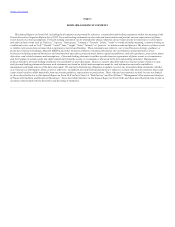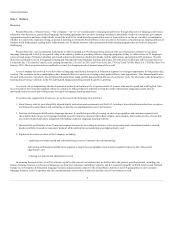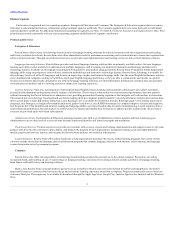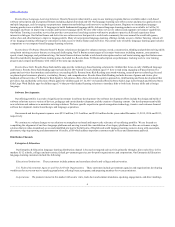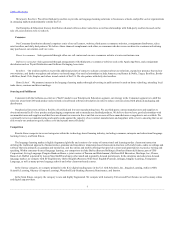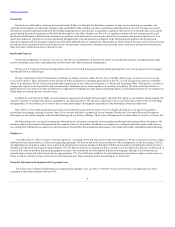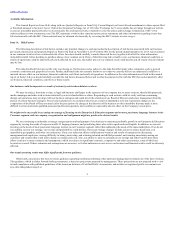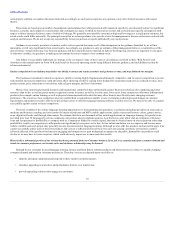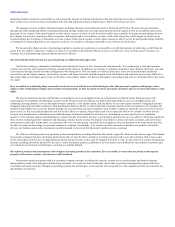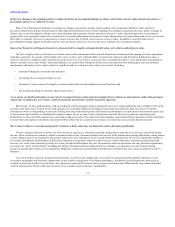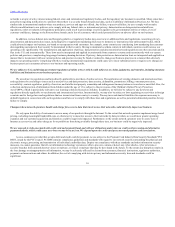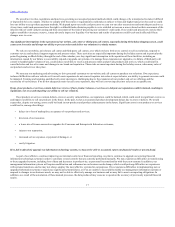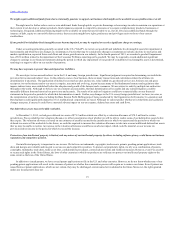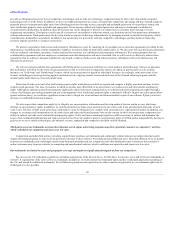Rosetta Stone 2015 Annual Report Download - page 12
Download and view the complete annual report
Please find page 12 of the 2015 Rosetta Stone annual report below. You can navigate through the pages in the report by either clicking on the pages listed below, or by using the keyword search tool below to find specific information within the annual report.
Table of Contents
• adapt and offer our products and services using rapidly evolving, widely varying and complex technologies;
• anticipate and meet consumer demand for additional languages, learning levels and new platforms for delivery;
• effectively position and market our products and services;
• identify and secure cost-effective means of marketing our products to reach the appropriate consumers;
• identify cost-effective sales distribution channels and other sales outlets where interested consumers will buy our products;
• anticipate and respond to consumer price sensitivity and pricing changes of competitive products; and
• identify and successfully implement ways of building brand loyalty and reputation.
We anticipate having to make investments in new products in the future and we may incur significant expenses without achieving the anticipated
benefits of our investment or preserving our brand and reputation. Investments in new products and technology are speculative, the development cycle for
products may exceed planned estimates and commercial success depends on many factors, including innovativeness, developer support, and effective
distribution and marketing. Customers might not perceive our latest offerings as providing significant new value and may reduce their purchases of our
offerings, unfavorably impacting revenue. We might not achieve significant revenue from new product and service investments for a number of years, if at all.
We also might not be able to develop new solutions or enhancements in time to capture business opportunities or achieve sustainable acceptance in new or
existing places. Furthermore, consumers may defer purchases of our solutions in anticipation of new products or new versions from us or our competitors. A
decline in consumer demand for our solutions, or any failure on our part to satisfy such changing consumer preferences, could harm our business and
profitability.
If the recognition by schools and other organizations of the value of technology-based education does not continue to grow, our ability to generate revenue
from organizations could be impaired.
Our success depends in part upon the continued adoption by organizations and potential customers of technology-based education initiatives. Some
academics and educators oppose online education in principle and have expressed concerns regarding the perceived loss of control over the education
process that could result from offering courses online. If the acceptance of technology-based education does not continue to grow, our ability to continue to
grow our Enterprise & Education business could be impaired.
We depend on discretionary consumer spending in the Consumer segment of our business. Adverse trends in general economic conditions, including retail
and online shopping patterns or consumer confidence, as well as other external consumer dynamics may compromise our ability to generate revenue.
The success of our business depends to a significant extent upon discretionary consumer spending, which is subject to a number of factors, including
general economic conditions, consumer confidence, employment levels, business conditions, interest rates, availability of credit, inflation, and taxation.
Adverse trends in any of these economic indicators may cause consumer spending to decline further, which could hurt our sales and profitability.
Because a significant portion of our Consumer sales are made to or through retailers and distributors, none of which has any obligation to sell our
products, the failure or inability of these parties to sell our products effectively could hurt our revenue and profitability.
We rely on retailers and distributors, together with our direct sales force, to sell our products. Our sales to retailers and distributors are concentrated on a
key group that is comprised of a mix of websites, such as Amazon.com and the Apple App Store; select retail resellers such as Barnes & Noble, Best Buy,
Target, Books-a-Million, Staples, and Sam's Club; and consignment distributors such as Wynit Distribution and Software Packaging Associates. Sales to or
through our retailers and distributors accounted for approximately 10% of our revenue for the year ended December 31, 2015, compared to 13% for the year
ended December 31, 2014.
We have no control over the amount of products that these retailers and distributors purchase from us or sell on our behalf, we do not have long-term
contracts with any of them, and they have no obligation to offer or sell our products or to give us any particular shelf space or product placement within their
stores. Thus, there is no guarantee that this source of revenue will continue at the same level as it has in the past or that these retailers and distributors will not
promote competitors' products over our products or enter into exclusive relationships with our competitors. Any material adverse change in the principal
commercial terms, material decrease in the volume of sales generated by our larger retailers or distributors or major disruption or termination of a relationship
with these retailers and distributors could result in a significant decline in our revenue and profitability. Furthermore, product display locations and
promotional activities that retailers undertake can affect the sales of
11




